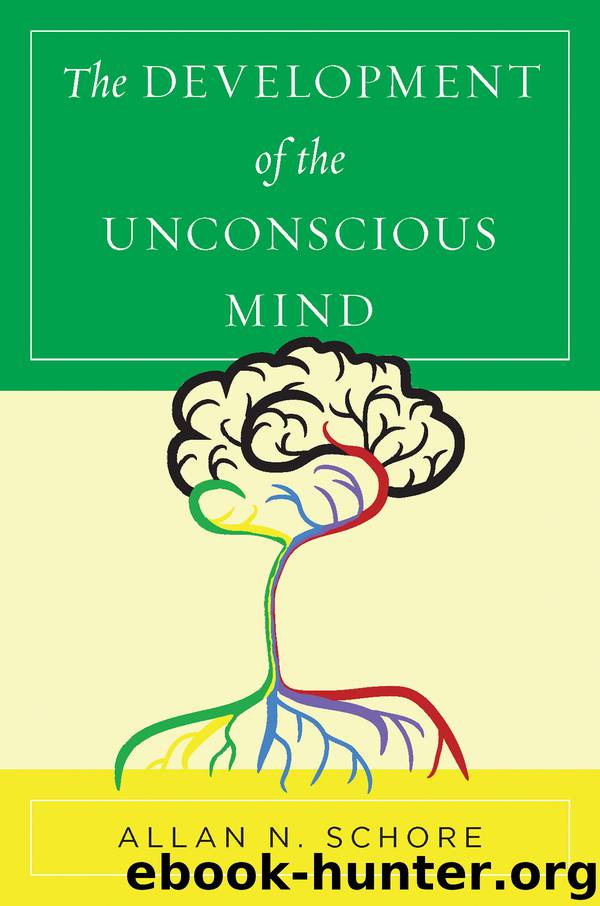The Development of the Unconscious Mind (Norton Series on Interpersonal Neurobiology) by Allan N. Schore

Author:Allan N. Schore
Language: eng
Format: epub
Tags: Epub3
Publisher: W. W. Norton & Company
Psychotherapy as a Relational Intervention That Promotes Emotional Well-Being
In my book The Science of the Art of Psychotherapy, I continued to elaborate an evidence-based clinical model that explicates the change mechanisms involved not only in reducing symptomatic behavior and negative cognitions, but also in promoting emotional well-being. Referring to patients with histories of relational trauma (borderline personality disorder), my colleague Russell Meares (2012) observed,
The fundamental experience of self is a right-hemispheric affair … when right-hemispheric function is diminished, so also are those features associated with the overarching concepts of self, including inhibitory control and a background state of well-being. (p. 296, italics added)
My ongoing studies in regulation theory attempt to update treatment models of psychotherapy with developmentally traumatized patients. All personality and psychiatric disorders represent disturbances of right brain intersubjectivity and affect regulation. An essential clinical principle of working with relational trauma and severe disturbances of affect regulation is that the empathic therapist helps the patient to reexperience relational trauma in affectively tolerable doses in the context of a safe environment, so that the overwhelming traumatic feelings can be regulated and adaptively integrated into the patient’s emotional life (see the chapter on enactment in Schore, 2012a). The focus of treatment is not on retrieving an explicit memory of attachment trauma in the first year, but on the effects of early relational trauma on evolving “character structure,” and deficits in adaptive right brain functions.
In accord with a relational psychodynamic model of psychotherapy, right brain processes that are reciprocally activated on both sides of the therapeutic alliance lie at the core of the psychotherapeutic change process (J. Schore, 2012). Meares (2012) described “a form of therapeutic conversation that can be conceived … as a dynamic interplay between two right hemispheres.” In these emotionally charged therapeutic encounters, the therapist’s right brain visual-facial, auditory-prosodic, and tactile-gestural capacities for the nonverbal communication and regulation of the patient’s emotional self-states are critical to the change process of psychotherapy (see Chapter 3 of Schore, 2003a). Ogden and colleagues (2005) concluded that the psychotherapy change mechanism is not in verbal language exchanges but in the empathic clinician’s background implicit, psychobiologically attuned, interactive affect regulation, a relational context that allows the patient to safely contact, describe, and regulate his or her inner subjective experience.
In working with patients who present with early right brain attachment trauma, therapeutic expertise is expressed not so much in uncovering verbal content by left brain interpretations that promote cognitive understanding as much as the clinician’s relational psychobiological capacities in implicit right brain emotional and social functions. My ongoing studies continue to suggest that change in trauma therapy is not an analytic left brain “talking cure” but a right brain “relational affect communicating and regulating cure” (for the latest update of this model, see Schore, 2014b, “The Right Brain Is Dominant in Psychotherapy,” and J. Schore and A. Schore, 2014, “Regulation Theory and Affect Regulation Psychotherapy: A Clinical Primer”). Thus, effective affect regulation therapy with infant, child, adolescent, and adult patients can act as a growth-facilitating
Download
This site does not store any files on its server. We only index and link to content provided by other sites. Please contact the content providers to delete copyright contents if any and email us, we'll remove relevant links or contents immediately.
The Longevity Diet by Valter Longo(5021)
The Body: A Guide for Occupants by Bill Bryson(4976)
Ikigai by Héctor García & Francesc Miralles(4125)
Limitless by Jim Kwik(3086)
The Checklist Manifesto by Atul Gawande(2779)
The Body by Bill Bryson(2569)
Memory Rescue by Daniel G. Amen(2378)
What Color Is Your Parachute? 2015 by Richard N. Bolles(2264)
Breath by James Nestor;(2229)
Becoming Myself by Irvin D. Yalom(2226)
Fat for Fuel by Joseph Mercola(1971)
Memory Rescue: Supercharge Your Brain, Reverse Memory Loss, and Remember What Matters Most by Amen Dr. Daniel G(1948)
Awakening Your Ikigai by Ken Mogi(1769)
Weight Training by Thomas Baechle(1739)
50 After 50 by Maria Leonard Olsen(1680)
Starting Over (Sugar Creek Romance ) by Jordan Silver(1652)
1610396766 (N) by Jo Ann Jenkins(1625)
The Telomerase Revolution by Michael Fossel(1625)
Dirt by Bill Buford(1612)
